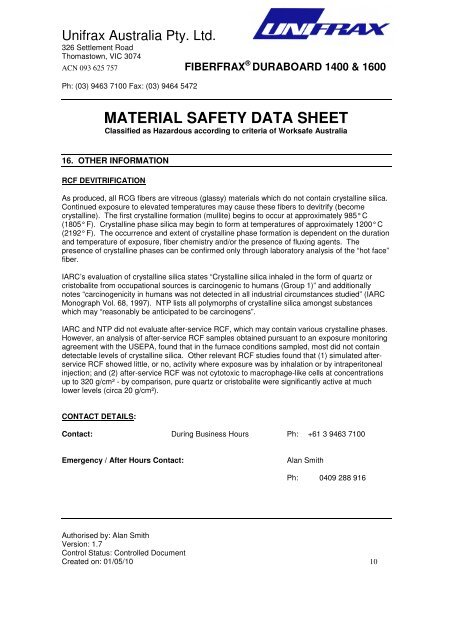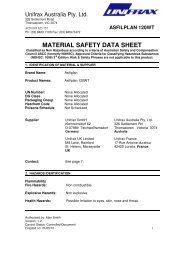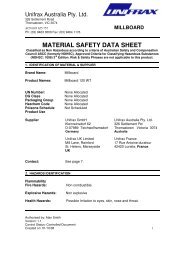MATERIAL SAFETY DATA SHEET - Unifrax Australia
MATERIAL SAFETY DATA SHEET - Unifrax Australia
MATERIAL SAFETY DATA SHEET - Unifrax Australia
You also want an ePaper? Increase the reach of your titles
YUMPU automatically turns print PDFs into web optimized ePapers that Google loves.
<strong>Unifrax</strong> <strong>Australia</strong> Pty. Ltd.<br />
326 Settlement Road<br />
Thomastown, VIC 3074<br />
ACN 093 625 757 FIBERFRAX ® DURABOARD 1400 & 1600<br />
Ph: (03) 9463 7100 Fax: (03) 9464 5472<br />
<strong>MATERIAL</strong> <strong>SAFETY</strong> <strong>DATA</strong> <strong>SHEET</strong><br />
Classified as Hazardous according to criteria of Worksafe <strong>Australia</strong><br />
16. OTHER INFORMATION<br />
RCF DEVITRIFICATION<br />
As produced, all RCG fibers are vitreous (glassy) materials which do not contain crystalline silica.<br />
Continued exposure to elevated temperatures may cause these fibers to devitrify (become<br />
crystalline). The first crystalline formation (mullite) begins to occur at approximately 985° C<br />
(1805° F). Crystalline phase silica may begin to form at temperatures of approximately 1200° C<br />
(2192° F). The occurrence and extent of crystalline phase formation is dependent on the duration<br />
and temperature of exposure, fiber chemistry and/or the presence of fluxing agents. The<br />
presence of crystalline phases can be confirmed only through laboratory analysis of the “hot face”<br />
fiber.<br />
IARC’s evaluation of crystalline silica states “Crystalline silica inhaled in the form of quartz or<br />
cristobalite from occupational sources is carcinogenic to humans (Group 1)” and additionally<br />
notes “carcinogenicity in humans was not detected in all industrial circumstances studied” (IARC<br />
Monograph Vol. 68, 1997). NTP lists all polymorphs of crystalline silica amongst substances<br />
which may “reasonably be anticipated to be carcinogens”.<br />
IARC and NTP did not evaluate after-service RCF, which may contain various crystalline phases.<br />
However, an analysis of after-service RCF samples obtained pursuant to an exposure monitoring<br />
agreement with the USEPA, found that in the furnace conditions sampled, most did not contain<br />
detectable levels of crystalline silica. Other relevant RCF studies found that (1) simulated afterservice<br />
RCF showed little, or no, activity where exposure was by inhalation or by intraperitoneal<br />
injection; and (2) after-service RCF was not cytotoxic to macrophage-like cells at concentrations<br />
up to 320 g/cm² - by comparison, pure quartz or cristobalite were significantly active at much<br />
lower levels (circa 20 g/cm²).<br />
CONTACT DETAILS:<br />
Contact: During Business Hours Ph: +61 3 9463 7100<br />
Emergency / After Hours Contact: Alan Smith<br />
Ph: 0409 288 916<br />
Authorised by: Alan Smith<br />
Version: 1.7<br />
Control Status: Controlled Document<br />
Created on: 01/05/10 10






